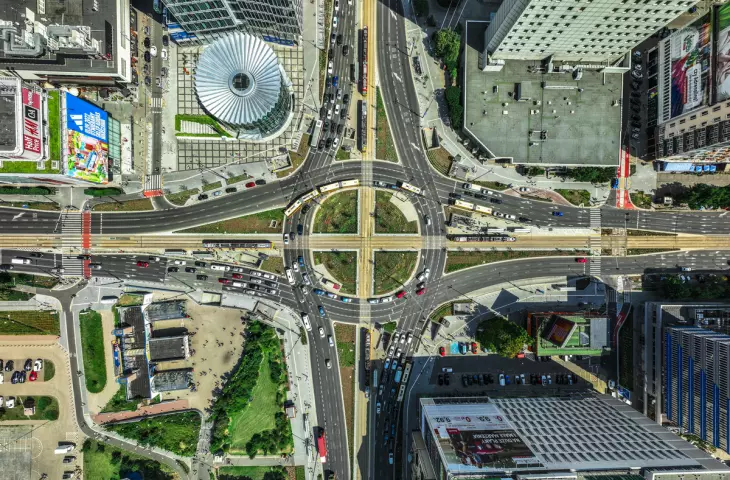Although the scale of the changes introduced at the Dmowskiego Roundabout in Warsaw does not knock, the effects it has brought are very satisfactory. Thousands of people use the pedestrian crossings designated at one of the main intersections in the center of Warsaw, as confirmed by traffic measurements.
Pedestrian bypass of the Dmowski Roundabout — this is how the solution introduced in 2022 in the center of Warsaw is sometimes called. Activists who have been calling for the humanization of this road junction for years pointed out that the project has been significantly truncated by officials. Crossings are in fact not designated at the rondabout itself, but the nearest crossings. The continuity of bicycle paths has not been preserved and conflicts between pedestrians and cyclists have been ruled out. Cars still have the most space in this place. However, the change brought about by even a partial solution to this situation shows the transformative potential of simple changes in traffic organization and small adjustments to public spaces.
Photo: Wikimedia Commons
overcoming barriers
The new surface crossings around the Dmowskiego traffic circle are one of the key investments in the „New Center of Warsaw” project. Thanks to them, it is no longer necessary to go underground when passing through the very center of Warsaw. The newly delineated zebras save time, but most importantly, they make it easier to enter the extended and widened streetcar stops. Until now, especially for people with reduced mobility, this was almost impossible. New surface crossings on Marszałkowska Street were created at the level of Widok and Nowogrodzka Streets, and on Jerozolimskie Avenue at the level of Parking and Poznańska Streets.
Photo: ZDM Warszawa
research confirms predictions
It turns out that pedestrians do not want to be relegated to the underground, even at the cost of waiting at traffic lights. The traffic study was conducted on Tuesday, September 13, 2022. Traffic on the traffic circle was measured at 26 points — at underpass entrances, bus stop accesses, surface crossings and bicycle crossings. To make the results reliable, traffic was measured in the morning (6:30-9:30 am) and in the afternoon (3-6 pm). A total of 58,226 people were counted during both periods, including 55,992 pedestrians, 1,759 bicyclists and 475 people on scooters, for example.
Pedestrians more than cars
The new surface crossings were very popular. They are used by 21% of traffic in the morning peak and 28% in the afternoon peak. A total of 1,676 people per hour used the overground crossings in the morning peak, and as many as 3,998 in the afternoon peak. Still popular overground crossings at this location are a result of, among other things, subway stations and the need to go underground for transfers. The most popular underpass on Widok Street was used by an average of 1,479 people per hour during the afternoon peak. By comparison, the afternoon peak of car traffic on the Marszalkowska Street roadway is just over 1,200 vehicles per hour. Pedestrians are therefore more numerous here than cars.
Photo: ZDM Warsaw
snail's pace of change
Knowing the results of traffic measurements, but also observing the popularity of surface crossings in person, it is all the more saddening to see the slow pace with which solutions to humanize the main arteries of the capital's downtown are being introduced. While waiting for designs, agreements and tenders, the city is not reaching for temporary solutions, which would also be a great tool for testing the specific parameters of the target changes.
What's more, temporary changes such as on Zgoda Street — introducing solutions known from woonerfs after the opening of the rebuilt Five Corners Square — are unable to survive. The less than 150-meter-long section of the calmed street has not even lasted a few months, and the pots limiting car traffic have been pushed onto the sidewalks, limiting pedestrian space. Why the city does not reach for solutions known from European cities, or Polish cities (and therefore in line with local legal conditions) remains a mystery — and at the same time a situation uniquely at the hands of motorists.


































